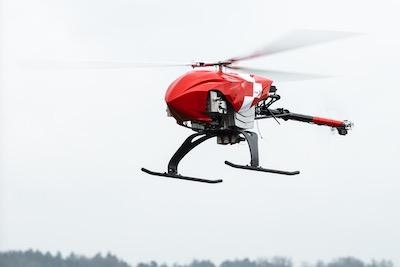Equipped With Thermal And Other Sensors To Assist In SAR
Rega presented a new type of aircraft for searching for missing persons at its recent annual Media conference. The newly developed Rega drone can autonomously scan large search areas and is equipped with various sensors, such as a thermal camera. As a result, in future, Rega will have at its disposal an additional device to help it search for people in distress.

Over the last year and a half, Rega has been working on its own drone project. In future, the Rega drone is to be deployed on missions to search for missing, injured or ill persons to supplement the conventional resources - for example, if the helicopter has to remain on the ground due to poor visibility. Such missions are performed in close collaboration with other rescue partners, in particular the police. Further comprehensive test flights are necessary before the drone system can be used in search operations as from 2020.
"Ever since it was founded, Rega has continually used cutting-edge technology to further improve air rescue and to come to the aid of even more people in distress", says Rega CEO Ernst Kohler. "I am confident that the Rega drone will expand our scope of operations even further." When developing the drone system, Rega was able to draw on its decades of experience in conducting countless search missions. In the last year alone, Rega searched for missing persons from the air on around 160 occasions because there was good reason to believe that a person needed help.
"We observed the development of drone technology from an early stage and were always convinced that drones could be of help in particular on search missions," says Head of Helicopter Operations Sascha Hardegger, who is in charge of the project. However, there is currently no drone system on the market that meets all of Rega's requirements. In particular, it is not possible to operate a relatively small, lightweight and flexible drone over a distance of several kilometres and for several hours without visual contact with the drone pilot. "As a result, we took the initiative and decided to develop a Rega drone ourselves in collaboration with suitable partners", says Hardegger. Rega has spent the last 18 months or so intensively working on its own drone project with the aim of making this additional operational device available for search missions in the very near future.

With its three rotor blades and a rotor diameter of just over two six feet, the new Rega drone looks like a mini helicopter and in appearance has little in common with commercially available multicopter drones. During a search mission, it flies at an altitude of 260 to 330 feet above ground level and, using satellite navigation, it scans large search areas precisely and autonomously following a predefined route. It is also able to independently detect and avoid other aircraft or obstacles, such as helicopters and overhead cables. This is possible thanks to anti-collision systems, coupled with countless data stored in the drone's in-flight computer, such as digital models of the terrain and obstacle databases. The drone is not deployed over densely populated regions or in the vicinity of airports or airfields. In addition, it is equipped with an emergency parachute.
Various sensors on board the drone make it possible to locate missing persons from the air. The signals from the infrared and daylight cameras are categorized in real-time on board the drone with the aid of a self-learning algorithm. This software is being developed in collaboration with the ETH Zurich. If, based on the pixel pattern of the images, the algorithm "presumes" to have located a person, the drone immediately relays this information to the operator on the ground. It is also planned to use an integrated mobile phone tracking function to search for injured or ill persons. This allows the Rega drone to locate a mobile phone in an uninhabited area from a distance of several hundred metres and thus most probably also find its owner. The prototype of this device is currently being trialled in collaboration with the police, who are responsible for emergency searches for missing persons. Here particular attention is paid to protecting sensitive data.
"Even if the drone is unmanned and can fly autonomously, it still needs a well-trained drone crew, comprising an operator and a pilot, to coordinate the search with the various rescue teams and to deploy the drone effectively," Sascha Hardegger explains. "Difficult person searches only have a chance of succeeding if all the rescue teams involved work closely together. In certain cases, the drone will be a useful supplementary aid, but it will never completely replace the Rega helicopter and its crew. If the search for an ill or injured person proves successful, a Rega helicopter or other form of rescue will still be needed to recover the person or fly medical assistance to the site of the incident."
(Images provided with Rega news release)
 Classic Aero-TV: The Switchblade Flying Car FLIES!
Classic Aero-TV: The Switchblade Flying Car FLIES! ANN FAQ: Q&A 101
ANN FAQ: Q&A 101 ANN's Daily Aero-Term (04.12.24): Discrete Code
ANN's Daily Aero-Term (04.12.24): Discrete Code ANN's Daily Aero-Term (04.13.24): Beyond Visual Line Of Sight (BVLOS)
ANN's Daily Aero-Term (04.13.24): Beyond Visual Line Of Sight (BVLOS) ANN's Daily Aero-Linx (04.13.24)
ANN's Daily Aero-Linx (04.13.24)




